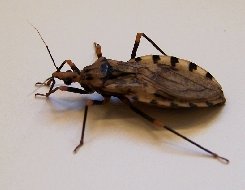
Triatoma protracta is a species of any mid sized insect in the family Reduviidae. It is known commonly as the western bloodsucking conenose. It is distributed in the western United States and Mexico.

Hemiptera is an order of insects, commonly called true bugs, comprising over 80,000 species within groups such as the cicadas, aphids, planthoppers, leafhoppers, assassin bugs, bed bugs, and shield bugs. They range in size from 1 mm (0.04 in) to around 15 cm (6 in), and share a common arrangement of piercing-sucking mouthparts. The name "true bugs" is often limited to the suborder Heteroptera.

The Reduviidae is a large cosmopolitan family of the suborder Heteroptera of the order Hemiptera. Among the Hemiptera and together with the Nabidae almost all species are terrestrial ambush predators; most other predatory Hemiptera are aquatic. The main examples of non-predatory Reduviidae are some blood-sucking ectoparasites in the subfamily Triatominae, with a few species from South America noted for their ability to transmit Chagas disease. Though spectacular exceptions are known, most members of the family are fairly easily recognizable: they have a relatively narrow neck, sturdy build, and formidable curved proboscis. Large specimens should be handled with caution, if at all, because they sometimes defend themselves with a very painful stab from the proboscis.

The members of the Triatominae, a subfamily of the Reduviidae, are also known as conenose bugs, kissing bugs, or vampire bugs. Other local names for them used in the Americas include barbeiros, vinchucas, pitos, chipos and chinches. Most of the 130 or more species of this subfamily feed on vertebrate blood; a very small portion of species feed on invertebrates. They are mainly found and widespread in the Americas, with a few species present in Asia and Africa. These bugs usually share shelter with nesting vertebrates, from which they suck blood. In areas where Chagas disease occurs, all triatomine species are potential vectors of the Chagas disease parasite Trypanosoma cruzi, but only those species that are well adapted to living with humans are considered important vectors. Also, proteins released from their bites have been known to induce anaphylaxis in sensitive and sensitized individuals.

Triatoma is a genus of assassin bug in the subfamily Triatominae. The members of Triatoma are blood-sucking insects that can transmit serious diseases, such as Chagas disease. Their saliva may also trigger allergic reactions in sensitive individuals, up to and including severe anaphylactic shock.

Triatoma brasiliensis is now considered the most important Chagas disease vector in the semiarid areas of northeastern Brazil. T. brasiliensis occurs in 12 Brazilian states, including Maranhão, Piauí, Ceará, Rio Grande do Norte, and Paraíba.
Triatoma platensis is an ornitophilic species of triatomine in the family Reduviidae. It is found in Argentina, Bolivia, Brazil, Paraguay and Uruguay.

Triatoma gerstaeckeri is an assassin bug in the genus Triatoma. It is an important vector of Trypanosoma cruzi, the causative agent of Chagas disease. The range of T. gerstaeckeri is from the south-western United States to north-eastern Mexico. T. gerstaeckeri goes through three stages during its paurometabolous life cycle: egg, nymphal instars and adult.
Triatoma indictiva is an arthropod in the assassin bug family of Reduviidae, and is an important vector of Trypanosoma cruzi. T. cruzi is the protozoan that causes Chagas Disease, which affects approximately eight million people a year in the western hemisphere alone. Triatoma indictiva is found in Mexico and throughout the southern United States, including Arizona and Texas.

Zelus cervicalis is a species of assassin bug in the family Reduviidae. It is found in Central America, North America, and South America.

Triatoma lecticularia is a species of kissing bug in the family Reduviidae. It is found in Central America and North America.
Zeluroides is a genus of assassin bugs in the family Reduviidae. There are at least two described species in Zeluroides.
Pseudosaica is a genus of assassin bugs in the family Reduviidae. There are at least two described species in Pseudosaica.
Triatoma rubida is a species of kissing bug in the family Reduviidae. It is found in Central America and North America.
Triatoma neotomae is a species of kissing bug in the family Reduviidae. It is found in Central America and North America.
Reduvius sonoraensis is a species of assassin bug in the family Reduviidae. It is found in Central America and North America. It can have two types that are discernably different by the fifth instar: those with short wing pads and those with long wing pads.
Paratriatoma is a genus of kissing bugs in the family Reduviidae.There is one described species in Paratriatoma, P. hirsuta.

Zelus tetracanthus, the four-spurred assassin bug, is a species of assassin bug in the family Reduviidae. It is found in the Caribbean Sea, Central America, North America, and South America. Adults are brown, black, or gray and have a body length of 10–16 mm. Their antennae and legs are long and slender. They have a row of four spurs across their thorax. Both adults and nymphs use a sticky secretion to capture prey.

Linshcosteus is a genus of assassin bugs in the subfamily Triatominae. It is the only genus of Triatomines restricted to the Old World within the mostly Neotropical subfamily Triatominae and consists of six species restricted to peninsular India. Within the Triatominae, the genus is differentiated by the lack of a prosternal stridulatory furrow and a short rostrum that does not reach the prosternum. Adults feed on vertebrate blood.

Triatoma sordida is an assassin bug within the genus Triatoma. This species consists of three subspecies. Also referred to as kissing bugs, T.sordida are most well known for their role as a secondary vector of Chagas Disease. Inhabiting warm, dry climates, T.sordida are widely distributed throughout South America, occupying houses, farming structures, and wild habitats. Pest control is currently focused on insecticide application. However, biological controls utilizing fungi appear promising.











